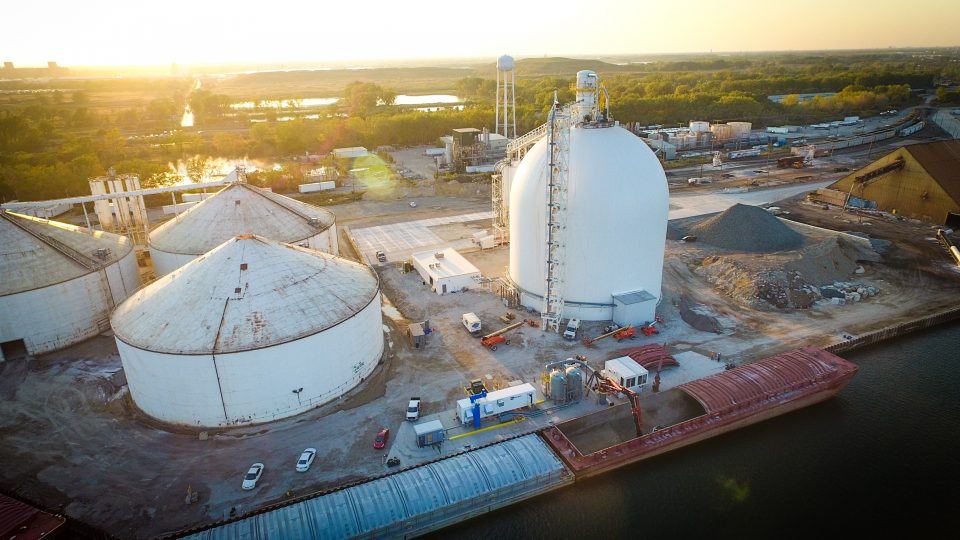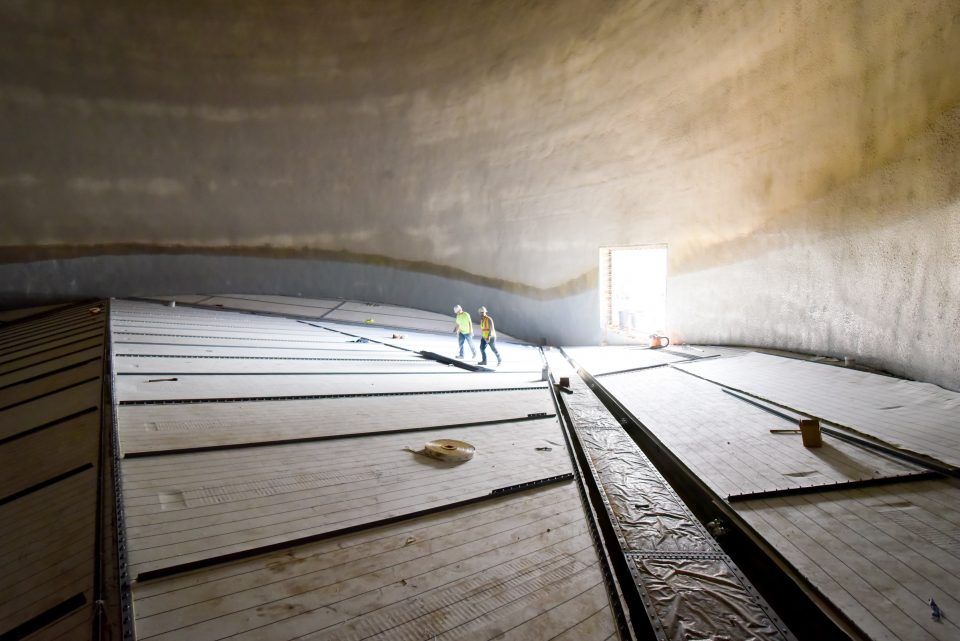Bulking up on storage was a way to stay ahead of the curve for Ozinga.
“It is our view that the country is in the early stages of an expansionary period, creating extra demands on our raw materials,” Ozinga President Marty Ozinga IV said. “Storage helps us manage our supply chain to ensure reliable and economical sources of quality materials.”
As part of their proactive approach, the company contracted with Dome Technology to build a DomeSilo™ in Chicago, Illinois, then turned around and completed a full terminal upgrade two years later.
First things first: A storage dome
The first stage of the Ozinga project was, in a word, enormous. Ozinga needed to beef up cement storage, and that equated to a 50,000-metric-ton DomeSilo built with steel-reinforced concrete and all the monitoring and loading systems to carry operations into the next several decades. Dome Technology was hired to manage the entire scope of the project, from the barge unloader and dome storage to the reclaim system and truck load-out.
Until this point, Ozinga brought in product by barge and was using three 10,000-ton silos to store it, but the company needed to increase efficiency and storage capacity. Ozinga management considered slip-form concrete silos, bolted steel silos and flat storage for the Chicago site, but “we determined that the dome storage was the most economical and efficient form of storage for the amount of material we wanted to store and the amount of annual put-through,” Ozinga said.

According to Ozinga, the company had two main criteria for the new dome. One was a location with ample access to different modes of transportation including the river, rails, the Great Lakes and the highway. The selected Chicago site met these needs and boasted space for further expansion. The other non-negotiable was redundancy, an advantage made possible by custom pneumatic transport and reclaim systems.
These must-haves required a solid plan from the start, including site considerations and infrastructure placement. In addition, a host of mechanical work was required. The custom dome and all its associated systems comprised a Dome Technology design-build project with design support from Engineering System Solutions (ES2).
Completed in 2017, the DomeSilo is 125 feet in diameter and 138 feet tall. Product is loaded into the storage pneumatically via a barge unloader, and dual Fuller-Kinyon pumps convey product from the dome to two day bins. Dust-collection systems are installed, and level monitoring allows site managers to keep constant tabs on the amount of stored product.

The dome can be loaded at a fill rate of 300 metric tons per hour. Cement enters the filter receiver at the apex and is then discharged into the dome or directly to loadout silos. This system was designed with flexibility in mind; Ozinga was bringing in fly ash and slag on barges and wanted to utilize this same system to load these products from barge to trucks.
To comprise the redundancy plan, FLSmidth provided a Docksider Model DS-1 barge unloader, a Ful-Floor fluidized reclaim system and a Fuller-Kinyon transfer system. The double dihedral, fully fluidized floor discharges product on two sides of the dome. A fluidized floor allows companies to aerate different areas of the floor at different times, so fluidization is especially even and does not asymmetrically load the dome structure.
The advantages of this floor system are twofold: A large reclaim tunnel is unnecessary as product is fed to the sides of the dome, and all mechanical equipment is stored outside so maximum interior space can be utilized for storage. Also, an aeration pipe runs under the peak in the floor in a small tunnel, drastically reducing penetrations to the exterior wall where pipe would otherwise run around the perimeter. Reduced access points on the dome’s exterior means fewer possible areas for moisture entrance. And since fluidized floors are operated by multiple valves and blowers, they’re low maintenance, and the risk of breakdown is lower than that associated with mechanical reclaim equipment.

Because the dome was to be built on an existing wood-pile foundation that had once supported silos, action had to be taken to account for the possibility of settlement “as the piles may have lost integrity of 60 years,” ES2 engineer Adam Aagard said. The dome did not experience a concerning amount of settlement, “but they didn’t want to take that gamble, and neither did we,” he said, adding that the dome and its foundation are sufficiently robust to weather extreme weather conditions or natural disasters.
According to Ozinga, the dome will help the company secure reliable and economical sources of raw materials—a capability that will help the company continue to distinguish itself from the competition. “In the long run, this (dome) will help secure the future of Ozinga as an independent, American-owned and operated family business,” he said.

Second stage: Terminal expansion
With the dome complete, the stage was set for the second portion of Ozinga’s project: terminal expansion with a focus on receiving fly ash and slag. Dome Technology acted as construction manager and oversaw the erection of two 4,000-ton silos for storing slag and fly ash, one rail silo, one blower building/electrical room and three operator load-out kiosks. Two new truck loadout lanes and scales and one new rail scale were also added to the site, as well as automation and programming for these systems.
Another key component of the expansion included the ability to transfer from barge to storage. An additional conveyance line was added and buried, and two new 4,000-ton drive-through steel silos were built, one for slag and one for fly ash. Each has its own loadout lane and FK pump that can transfer product to the silos at 50 to 80 tons per hour, depending on the product. These pumps can also transfer to the new rail loadout silo that holds 300 tons.
An existing three-pack of silos used for loading trucks was improved. Ozinga opted to modify their hopper and install a covered structure so operations could proceed regardless of the weather. The FK pump was also upgraded for a higher loading rate, as was the compressed air system.
In April 2019 the fully upgraded terminal was ready for operations with a host of conveyance options. For offloading, product can be conveyed from a barge, railcar or truck; product can also be transferred from the existing 50,000-metric-ton dome. On the loading side, inbound product can be housed in one of the 4,000-ton silos, the rail silo or the existing 10,000-ton tanks, or it can be loaded into trucks or rail cars—“that’s a lot of versatility,” said Dome Technology project manager Brent Toone.
For 40 years Dome Technology has developing innovative ideas and expanding its expertise. The Ozinga terminal expansion is an example of what the team can do for cement companies worldwide. “The projects for Ozinga are a good example of Dome Technology’s capability to take a project from conception all the way through to commissioning,” Dome Technology CEO Bradley Bateman said.
By Rebecca Long Pyper for Dome Technology
Editor’s note: The preceding was published in the February 2021 issue of International Cement Review.